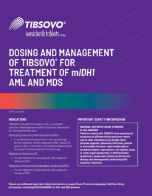TIBSOVO offers convenient, once-daily oral dosing for patients with mIDH1 MDS1
500 mg
(2 x 250-mg film-coated tablets)
Tablets not shown at actual size.
Taken orally, once daily until disease progression or unacceptable toxicity
mIDH1, mutated isocitrate dehydrogenase-1.

Review the TIBSOVO Dosing & Management Guide to learn more.
DownloadDosing guidance for TIBSOVO1
Treatment with TIBSOVO has not been studied in patients with pre-existing severe renal or hepatic impairment. For patients with pre-existing severe renal or hepatic impairment, consider the risks and potential benefits before initiating treatment with TIBSOVO.
TIBSOVO should be taken at about the same time each day.
If a dose is missed or not taken at the usual time, patients should take the missed dose as soon as possible and at least 12 hours prior to the next scheduled dose. They should return to the normal schedule the following day. They should not take 2 doses within 12 hours.
If a dose is vomited, patients should not take a replacement dose; they should wait until the next scheduled dose is due.
TIBSOVO tablets should not be split, crushed, or chewed.
TIBSOVO can be taken with or without food but should not be taken with a high-fat meal.a
Managing adverse reactions to TIBSOVO1
- Assess blood counts and blood chemistries prior to the initiation of TIBSOVO, at least once weekly for the first month, once every other week for the second month, and once monthly for the duration of therapy
- Monitor blood creatine phosphokinase weekly for the first month of therapy
- Obtain an ECG prior to treatment initiation. Monitor ECGs at least once weekly for the first 3 weeks of therapy and then at least once monthly for the duration of therapy. Manage any abnormalities promptly
Differentiation syndrome1
- Symptoms of differentiation syndrome in patients treated with TIBSOVO included noninfectious leukocytosis, peripheral edema, pyrexia, dyspnea, pleural effusion, hypotension, hypoxia, pulmonary edema, pneumonitis, pericardial effusion, rash, fluid overload, tumor lysis syndrome, and creatinine increased
- Differentiation syndrome occurred as early as 1 day and up to 3 months after TIBSOVO initiation and has been observed with or without concomitant leukocytosis
- If differentiation syndrome is suspected, administer systemic corticosteroids and initiate hemodynamic monitoring until symptom resolution and for a minimum of 3 days
- Interrupt TIBSOVO if severe signs and/or symptoms persist for more than 48 hours after initiation of systemic corticosteroids
- Resume TIBSOVO when signs and symptoms improve to Grade 2a or lower
- Symptoms of differentiation syndrome may recur with premature discontinuation of corticosteroid and/or hydroxyurea treatment
Noninfectious leukocytosis1
- Initiate treatment with hydroxyurea, as per standard institutional practices, and leukapheresis if clinically indicated
- Taper hydroxyurea only after leukocytosis improves or resolves
- Interrupt TIBSOVO if leukocytosis is not improved with hydroxyurea, and then resume TIBSOVO at 500 mg daily when leukocytosis has resolved
QTc interval greater than 480 msec to 500 msec1
- Monitor and supplement electrolyte levels as clinically indicated
- Review and adjust concomitant medications with known QTc interval-prolonging effects
- Interrupt TIBSOVO
- Restart TIBSOVO at 500 mg once daily after the QTc interval returns to ≤480 msec
- Monitor ECGs at least weekly for 2 weeks following resolution of QTc prolongation
QTc interval greater than 500 msec1
- Monitor and supplement electrolyte levels as clinically indicated
- Review and adjust concomitant medications with known QTc interval-prolonging effects
- Interrupt TIBSOVO
- Resume TIBSOVO at a reduced dose of 250 mg once daily when QTc interval returns to within 30 msec of baseline or ≤480 msec
- Monitor ECGs at least weekly for 2 weeks following resolution of QTc prolongation
- Consider re-escalating the dose of TIBSOVO to 500 mg daily if an alternative etiology for QTc prolongation can be identified
QTc interval prolongation with signs/symptoms of life-threatening arrhythmia1
- Discontinue TIBSOVO permanently
Guillain-Barré syndrome1
- Discontinue TIBSOVO permanently
Other Grade 3 adverse reactions1
- Interrupt TIBSOVO until toxicity resolves to Grade 2a or lower
- Resume TIBSOVO at 250 mg once daily; may increase to 500 mg once daily if toxicities resolve to Grade 1a or lower
- If Grade 3a or higher toxicity recurs, discontinue TIBSOVO
bGrade 1 is mild, Grade 2 is moderate, Grade 3 is severe, Grade 4 is life-threatening.
ECG, electrocardiogram; QTc, corrected QT interval.
Drug-drug interactions with TIBSOVO1
Strong or moderate CYP3A4 inhibitors
- Coadministration increased ivosidenib plasma concentrations, which may increase the risk of QTc interval prolongation
- Consider alternative therapies that are not strong or moderate CYP3A4 inhibitors
- If coadministration is unavoidable, reduce TIBSOVO to 250 mg once daily. If the strong inhibitor is discontinued, increase the TIBSOVO dose (after at least 5 half-lives of the strong CYP3A4 inhibitor) to the recommended dose of 500 mg once daily
- Monitor patients for increased risk of QTc interval prolongation
Strong CYP3A4 inducers
- Coadministration decreased ivosidenib plasma concentrations
- Avoid coadministration
QTc prolonging drugs
- Coadministration may increase the risk of QTc interval prolongation
- Avoid coadministration with TIBSOVO or replace with alternative therapies
- If coadministration is unavoidable, monitor patients for increased risk of QTc interval prolongation
Effect of TIBSOVO on other drugs
- Ivosidenib induces CYP3A4 and may induce CYP2C9
- Coadministration will decrease concentrations of drugs that are sensitive CYP3A4 substrates and may decrease the concentrations of drugs that are sensitive CYP2C9 substrates
- Use alternative therapies that are not sensitive substrates of CYP3A4 and CYP2C9
- Do not administer TIBSOVO with antifungal agents that are substrates of CYP3A4 (such as itraconazole or ketoconazole) due to expected loss of antifungal efficacy
- Coadministration may decrease the concentrations of hormonal contraceptives. Consider alternative methods of contraception
- If coadministration with sensitive CYP3A4 substrates or CYP2C9 substrates is unavoidable, monitor patients for loss of therapeutic effect of these drugs
QTc, corrected QT interval.
